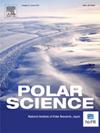An investigation into oil spill dynamics affected by floe-like obstacles with various distributions
IF 2
4区 地球科学
Q3 ECOLOGY
引用次数: 0
Abstract
This study investigates the spreading behavior of oil spills under simulated Arctic sea ice conditions with varying concentrations below 60%. Experiments were conducted in a controlled environment using PVC pipes to mimic sea ice obstacles at concentrations of 13.4%, 26.7%, and 53.4%. Results showed that at lower concentrations, oil spreading isotropically in a circular pattern, while at the highest concentration, the spreading became anisotropic, forming a diamond shape influenced by the obstacle arrangement. Contrary to conventional numerical models that assume decreased diffusion rates with increased ice concentration, the findings suggest that the diffusion rate can increase at higher concentrations due to the spatial arrangement of obstacles. The study also highlights the predominant role of surface tension in driving oil spreading when the oil thickness is below 2 mm. These insights call for refinements in current models of oil spill behavior in ice-covered waters, emphasizing the need to consider both obstacle arrangement and interfacial dynamics for better spill prediction and management in Arctic regions.
不同分布的浮状障碍物对溢油动力学影响的研究
本研究调查了在不同浓度低于60%的模拟北极海冰条件下石油泄漏的扩散行为。实验在受控环境中进行,使用PVC管模拟海冰障碍物,浓度分别为13.4%、26.7%和53.4%。结果表明:低浓度时,原油呈各向同性圆形扩散;高浓度时,原油呈各向异性扩散,受障碍物排列影响形成菱形扩散;与传统的数值模型假设扩散速率随冰浓度的增加而降低相反,研究结果表明,由于障碍物的空间排列,扩散速率可以在较高浓度下增加。研究还表明,当油厚小于2 mm时,表面张力对油扩散起主导作用。这些见解要求对现有的冰覆盖水域溢油行为模型进行改进,强调需要考虑障碍物布置和界面动力学,以便更好地预测和管理北极地区的溢油。
本文章由计算机程序翻译,如有差异,请以英文原文为准。
求助全文
约1分钟内获得全文
求助全文
来源期刊

Polar Science
ECOLOGY-GEOSCIENCES, MULTIDISCIPLINARY
CiteScore
3.90
自引率
5.60%
发文量
46
期刊介绍:
Polar Science is an international, peer-reviewed quarterly journal. It is dedicated to publishing original research articles for sciences relating to the polar regions of the Earth and other planets. Polar Science aims to cover 15 disciplines which are listed below; they cover most aspects of physical sciences, geosciences and life sciences, together with engineering and social sciences. Articles should attract the interest of broad polar science communities, and not be limited to the interests of those who work under specific research subjects. Polar Science also has an Open Archive whereby published articles are made freely available from ScienceDirect after an embargo period of 24 months from the date of publication.
- Space and upper atmosphere physics
- Atmospheric science/climatology
- Glaciology
- Oceanography/sea ice studies
- Geology/petrology
- Solid earth geophysics/seismology
- Marine Earth science
- Geomorphology/Cenozoic-Quaternary geology
- Meteoritics
- Terrestrial biology
- Marine biology
- Animal ecology
- Environment
- Polar Engineering
- Humanities and social sciences.
 求助内容:
求助内容: 应助结果提醒方式:
应助结果提醒方式:


